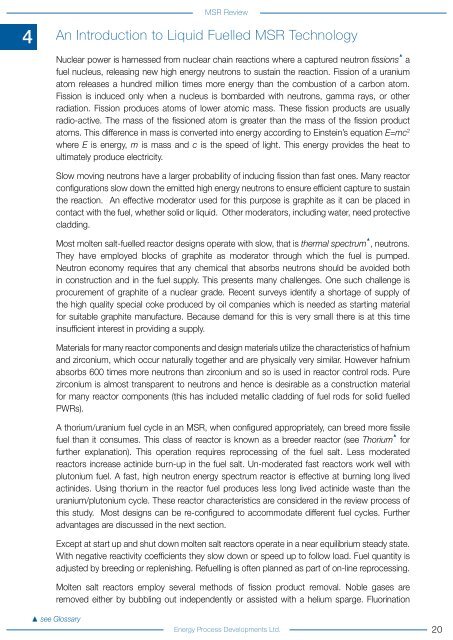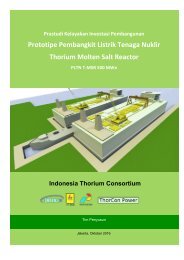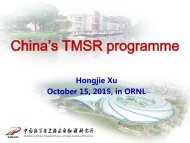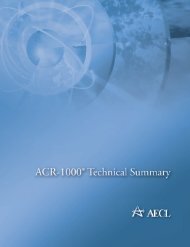MSR Review
EPD MSR Review Feasibility Study July 2015 1.02
EPD MSR Review Feasibility Study July 2015 1.02
Create successful ePaper yourself
Turn your PDF publications into a flip-book with our unique Google optimized e-Paper software.
4<br />
<strong>MSR</strong> <strong>Review</strong><br />
An Introduction to Liquid Fuelled <strong>MSR</strong> Technology<br />
Nuclear power is harnessed from nuclear chain reactions where a captured neutron fissions ▲ a<br />
fuel nucleus, releasing new high energy neutrons to sustain the reaction. Fission of a uranium<br />
atom releases a hundred million times more energy than the combustion of a carbon atom.<br />
Fission is induced only when a nucleus is bombarded with neutrons, gamma rays, or other<br />
radiation. Fission produces atoms of lower atomic mass. These fission products are usually<br />
radio-active. The mass of the fissioned atom is greater than the mass of the fission product<br />
atoms. This difference in mass is converted into energy according to Einstein’s equation E=mc 2<br />
where E is energy, m is mass and c is the speed of light. This energy provides the heat to<br />
ultimately produce electricity.<br />
Slow moving neutrons have a larger probability of inducing fission than fast ones. Many reactor<br />
configurations slow down the emitted high energy neutrons to ensure efficient capture to sustain<br />
the reaction. An effective moderator used for this purpose is graphite as it can be placed in<br />
contact with the fuel, whether solid or liquid. Other moderators, including water, need protective<br />
cladding.<br />
Most molten salt-fuelled reactor designs operate with slow, that is thermal spectrum ▲ , neutrons.<br />
They have employed blocks of graphite as moderator through which the fuel is pumped.<br />
Neutron economy requires that any chemical that absorbs neutrons should be avoided both<br />
in construction and in the fuel supply. This presents many challenges. One such challenge is<br />
procurement of graphite of a nuclear grade. Recent surveys identify a shortage of supply of<br />
the high quality special coke produced by oil companies which is needed as starting material<br />
for suitable graphite manufacture. Because demand for this is very small there is at this time<br />
insufficient interest in providing a supply.<br />
Materials for many reactor components and design materials utilize the characteristics of hafnium<br />
and zirconium, which occur naturally together and are physically very similar. However hafnium<br />
absorbs 600 times more neutrons than zirconium and so is used in reactor control rods. Pure<br />
zirconium is almost transparent to neutrons and hence is desirable as a construction material<br />
for many reactor components (this has included metallic cladding of fuel rods for solid fuelled<br />
PWRs).<br />
A thorium/uranium fuel cycle in an <strong>MSR</strong>, when configured appropriately, can breed more fissile<br />
fuel than it consumes. This class of reactor is known as a breeder reactor (see Thorium ▲<br />
for<br />
further explanation). This operation requires reprocessing of the fuel salt. Less moderated<br />
reactors increase actinide burn-up in the fuel salt. Un-moderated fast reactors work well with<br />
plutonium fuel. A fast, high neutron energy spectrum reactor is effective at burning long lived<br />
actinides. Using thorium in the reactor fuel produces less long lived actinide waste than the<br />
uranium/plutonium cycle. These reactor characteristics are considered in the review process of<br />
this study. Most designs can be re-configured to accommodate different fuel cycles. Further<br />
advantages are discussed in the next section.<br />
Except at start up and shut down molten salt reactors operate in a near equilibrium steady state.<br />
With negative reactivity coefficients they slow down or speed up to follow load. Fuel quantity is<br />
adjusted by breeding or replenishing. Refuelling is often planned as part of on-line reprocessing.<br />
Molten salt reactors employ several methods of fission product removal. Noble gases are<br />
removed either by bubbling out independently or assisted with a helium sparge. Fluorination<br />
▲ see Glossary<br />
Energy Process Developments Ltd. 20





